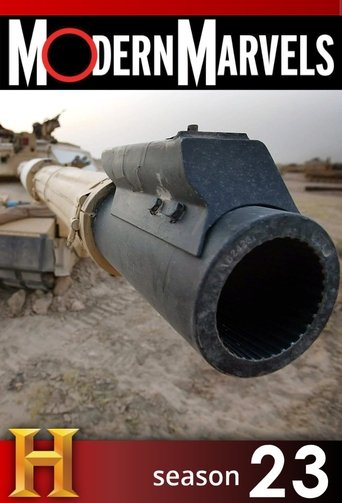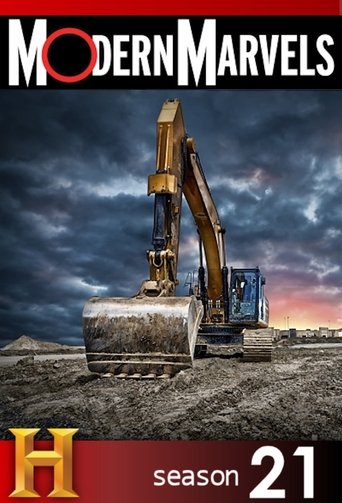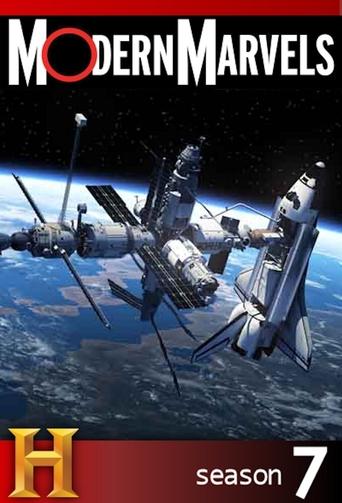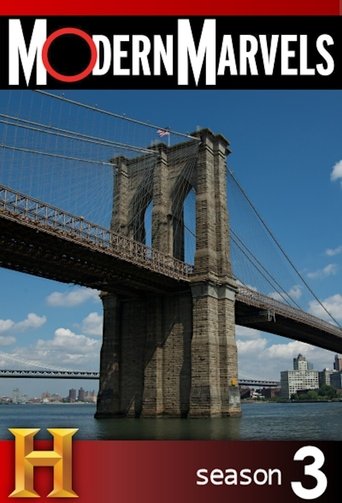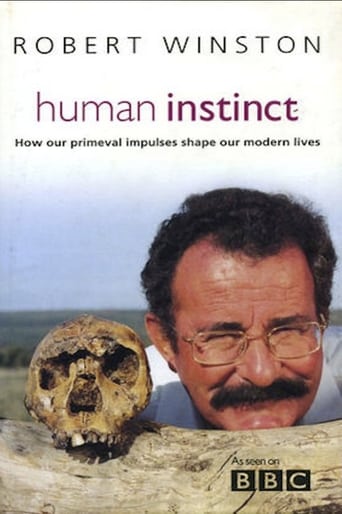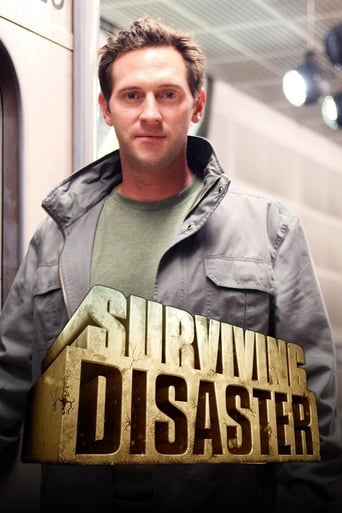Modern Marvels Season 11
HISTORY’s longest-running series moves to H2. Modern Marvels celebrates the ingenuity, invention and imagination found in the world around us. From commonplace items like ink and coffee to architectural masterpieces and engineering disasters, the hit series goes beyond the basics to provide insight and history into things we wonder about and that impact our lives. This series tells fascinating stories of the doers, the dreamers and sometime-schemers that create everyday items, technological breakthroughs and manmade wonders. The hit series goes deep to explore the leading edge of human inspiration and ambition.
Watch Trailer
Modern Marvels Season 11 Full Episode Guide
The second deadly hour examines more threats–both natural and manmade–that may endanger civilization. From the far reaches of space to tiny viruses, doomsday sources are many. But so are technologies used to keep doomsday at bay. Asteroids of significant size have hit our planet before and likely will again. Asteroid hunters demonstrate the Near Earth Asteroid Tracking (NEAT) program and methods being developed to destroy earth-aimed asteroids. Then, it's onto bioterrorism's sinister technologies–how highly virulent agents like smallpox and plague can be weaponized. Next, an ex-hacker turned cyber-security expert shows how vulnerable the nation's computers are to cyberterror. Finally, we visit the controversial world of biotechnology. Could genetically engineered crops backfire? Does a brave new world of genetically selected beings loom in our not-so-distant future?
Doomsday threats range from very real (nuclear arsenals) to controversial (global warming) to futuristic (nanotechnology, cyborgs, and robots). Despite the Cold War’s end, we live under the shadow of nuclear weapons, arms races, and accidental launches. Next, we stir up a hotter topic–the connection between global warming and fossil fuels–and ask if they’re cooking up a sudden, new Ice Age. And we examine 21st-century technologies that typify the dual-edged sword of EM Doomsday Tech /EM with massive potential for both creation and destruction–nanotechnology (engineering on a tiny scale), robotics, and cybernetics. We witness amazing applications in the works, wonder at the limitless promise, and hear warnings of a possible nano-doomsday, with tiny, out-of-control machines devouring everything around them.
Chaos in Guadalajara, Mexico, when the city streets explode; an airplane crash outside of Paris that ranks as one of the worst in history; two mining dams in Italy collapse engulfing a village in a tidal wave of sludge; a generation of children in a small Texas town are entombed in the rubble of their school; an oil tanker runs aground off the coast of England and introduces the world to the devastation of the first super spill… EM Engineering Disasters 16 /EM delves into the shocking chain of events leading up to each of these horrific catastrophes and examines resulting technological improvements designed to prevent similar tragedies in the future.
Battered and fried or simply raw–seafood is a popular dish, no matter how you serve it. Americans consume more than 5-billion pounds yearly, an order that takes more than a fishing rod to fill and worries conservationists. We follow the fish, the fishermen, and the science trying to preserve fisheries for future generations–from ancient ships on the Nile to a modern technologically sophisticated factory trawler on the Bering Sea to the University of New Hampshire's open-ocean aquaculture research project. And we witness a wide variety of fishing methods–from gillnetting and longlining STRONG /STRONG to lobster trapping. Hop aboard and sail through time and around the globe as we explore the harsh conditions of life at sea and experience firsthand one of history's deadliest jobs. Brace yourself and feel the ice-cold, salt spray on your face as we explore commercial fishing!
It comes in many deadly shapes and sizes, and the transportation of dangerous cargo is one of the most meticulously planned procedures in the shipping world. We hitch a ride on a “dynamite run” from explosives factory to construction site; learn how liquid natural gas is shipped, a fuel that could vaporize entire city blocks if ignited; accompany a Drug Enforcement Administration truck as it transports confiscated illegal drugs to an incinerator site for destruction; fly with Air Net as it moves radioactive pharmaceuticals from factory to hospital; and tag along with two tigers, part of a breeding program for endangered species, as they travel from Texas to Ohio. As each story progresses, we explore the history of the transport of that particular form of Dangerous Cargo.
Extruders, molds, in-line conveyor belts. Are these machines manufacturing adhesives, plastics, or parts for your car? No, they're making treats for your mouth–and you will see them doing their seductively tasty work in this scrumptious episode. First, we visit Utz Quality Foods in Hanover, Pennsylvania, that produces more than one million pounds of chips per week, and Snyder's of Hanover, the leading US pretzel manufacturer. Next, we focus on the world's largest candy manufacturer, Masterfoods USA, which makes Milky Way, Snickers, Mars, and M&Ms;, and take a lick at the world's largest lollipop producer, Tootsie Roll Industries. And at Flower Foods' Crossville, Tennessee plant, an army of cupcakes rolls down a conveyer belt. The final stop is Dreyer's Bakersfield, California plant, where 20,000 ice cream bars and 9,600 drumsticks roll off the line in an hour.
A series of construction errors causes a devastating flood that brings Chicago to a standstill. A deadly accident traps hundreds in a smoke-filled Alpine tunnel, with no ventilation. Three boilers explode on a Mississippi riverboat resulting in thousands of deaths and earning the disaster the title of the worst in maritime history. Two buildings, halfway around the world from each other, collapse from the same type of shoddy construction methods–14 years apart. And a cockpit warning system malfunctions, causing a fiery, fatal crash before the jetliner ever takes off. We interview design and construction experts as we investigate what went wrong. And we talk with rescue personnel, eyewitnesses, and victims as we visit the tragedies' sites to see what improvements have been implemented to insure against these kinds of disasters.
The US capital boasts many memorials, but none with a more bizarre history than the obelisk erected to America's first president. Over 55 stories high and weighing over 90,000 tons, the Washington Monument stands stalwart in the city's center. From concept to completion, it took 100 years–years filled with mystery, ceremony, conflict, government action, and inaction. Proposed in the late 1700s by a group of prominent citizens and finished in the late 1800s by the Army Corps of Engineers, the exterior is mainly Maryland white marble, while the interior is made of granite, iron…and a few surprises. How did it come together and why did it take so long? Historians tell stories of stalling bureaucracy, secret societies, and triumphant engineering. Stark and daunting on the outside, we let viewers know what's inside.
In this hour, we examine a massive oil tanker explosion that killed nine; a subway tunnel cave-in that swallowed part of Hollywood Boulevard; a freighter plane crash that destroyed an 11-story apartment building; an historic molasses flash flood; and a freeway ramp collapse that buried construction workers in rubble and concrete. Investigators from NTSB, Cal/OSHA, and Boeing, structural and geo-technical engineers, and historians explain how so much could have gone wrong, costing so many lives. And aided by computer graphics, footage and photos of the disasters, and visits to the locations today, we show viewers what caused these catastrophes and what design experts have done to make sure they never happen again.
When the men and women aboard a modern submarine hear the command to dive, they can take a measure of comfort in the fact that no US sub has been lost in nearly 40 years, though it’s been said that the sea is a more hostile environment than space. The tragedies of former disasters have not been forgotten or squandered and the Navy has been extremely motivated to find ever more effective ways to prevent them. We’ll examine sub disasters to discover what caused them and what they’ve taught us. And as we explore the early history of the submarine–including a sub used in the American Revolution and one used in the Civil War–we follow a modern crew using submarine simulators to train for disasters, study subs in the nuclear age, and explore state-of-the-art rescue technology.
In this hour, death seeps out of the ground into a neighborhood sitting on a toxic waste dump at Love Canal in New York; soldiers die during Desert Storm in 1991 when software flaws render Patriot Missiles inaccurate; on September 11, 2001, World Trade Center Building #7 wasn’t attacked, but seven hours after the Twin Towers collapsed, it too is mysteriously reduced to a pile of rubble; a night of revelry in Boston turns the Coconut Grove nightclub into an inferno that kills over 400 people in 1942; and the science of demolition is put to the test and fails when a building in Rhode Island, the “Leaning Tower of Providence”, stands its ground.
In the world of surveillance, Big Brother is not only watching, he’s also listening, analyzing, recording, scanning, and tracking every aspect of our lives. And with advanced surveillance technology, there’s virtually no place to hide. We’ll examine some of the most important and potentially terrifying equipment the world has ever seen…or rather, not seen…in this thriving surveillance revolution. We check out parabolic microphones that pick up conversations a mile a way, cameras that learn what and who to photograph, RadarVision that “sees through walls”, and Uninhabited Aerial Vehicles (UAVs). And we explore the mind-bending future of surveillance technology, while, of course, reviewing its surprising history.
In Milwaukee, 104 died after drinking contaminated tap water. At Texas A&M;, a tradition turned tragic when a pile of bonfire logs collapsed onto its builders. Thousands of US soldiers expired in known WWII deathtraps–Sherman Tanks. In 1973, 14 men working on a 26-story building died when supports were removed from wet concrete. And in 1993, Denver’s “dream” airport became a nightmare when its baggage-handling system ran amok. Aided by computer graphics, catastrophe footage, and visits to the locations today, MIT scientists, Center for Disease Control experts, WWII vets, bonfire builders, and construction engineers explain these tragedies and measures taken to prevent them in future.
Join us as we penetrate the history of the world’s most sophisticated tank–the M1 Abrams Main Battle Tank. In the most radical departure in U.S. tank design since WWII, the Supertank combines speed, heavy protective armor, and a fearsome 120mm main gun. In February 1991, the new and unproven Abrams tank was rapidly deployed on the frontline of Operation Desert Storm. Using night vision and laser targeting, the M1 Abrams tank destroyed the cream of Saddam Hussein’s armored Republican Guard.
The Japanese attack on Pearl Harbor was a move of unprecedented aggression that shook the U.S. out of its peaceful slumber and into WWII. But for 60 years, veterans of the destroyer USS Ward claimed they sank an enemy submarine outside the harbor more than an hour before the aerial attack began. The wreck was never found, and the story was dismissed. In August 2002, a dive team crossed its path and their find made headlines worldwide. We travel to Pearl Harbor to investigate the midget sub mystery.
Bridges are the lifeline of Japan. Since the 1930s, the island nation has dreamt of linking its many parts as a whole. But WWII diverted the incredible resources needed to accomplish this, and only since 1960 has the dream moved again, slowly, toward reality. The final step in this massive undertaking was the Akashi-Kaikyo Bridge, currently the longest single-span suspension bridge in the world. This marvel of architectonics stands as a testament to the genius of Asian engineering and, judged in a context that perhaps the Japanese understand best, as the most beautiful bridge in the world. We’ll watch it rise, from sketch to completion, and see how it fared during the massive Kobe earthquake.
Disasters profiled are a liquid natural gas explosion in Cleveland, the collapse of the Kansas City Hyatt walkway, flooding of the Yangtze River in 1931, as well as sinkholes caused by sewer collapses in San Francisco and Atlanta. Also features the impacts of asbestos on the modern world.
Gas–it makes a balloon go up, cooks our food, and fills our lungs. But this invisible state of matter does far more, and has a very visible impact on the world. We follow natural gas from well tip to stove top and trace its use from 3rd century BC Chinese salt producers to modern appliances. Next, we investigate the most plentiful gas in the universe–hydrogen–which may also prove to be the most powerful. We also experience the cryogenic world of industrial gasses–what they do and where they come from–as we travel to the British Oxygen Company's Braddock Air Separation Plant to see how they freeze millions of tons of oxygen and nitrogen. And at the Bush Dome Helium Reserve in Texas, we learn why the US government sits atop 36-billion cubic feet of the stuff. Finally, we look inside the colorful world of gas and neon lights. So lay back, breathe deep, and count backwards from 10…
The vehicles that transport the President of the United States aren’t your ordinary planes, trains, and automobiles. They are top-secret. And for your Average Joe, there’s only two ways to find out what they’re really like inside–either get elected or watch Presidential Movers on Modern Marvels.
Disasters investigated include: the 1984 Union Carbide debacle in Bhopal, India, where a toxic chemical release killed 3,800 people and left 11,000 with disabling respiratory ailments; and the 2003 sudden collapse of a 10-story parking garage at the Tropicana in Atlantic City, New Jersey that killed four and injured 20. We find out why a series of structures in Hutchinson, Kansas mysteriously caught fire and exploded in 2001; and examine the 1933 construction of a canal ordered by Soviet dictator Joseph Stalin that later proved to be nearly useless and cost many lives. And we get to the bottom of a maritime mystery, when a tanker carrying non-explosive materials in San Francisco Bay blew up in 1983.
What happens when the calculations of builders and engineers prove wrong and their constructs come tumbling down? In this episode, we examine the 1987 failure of the Schoharie Creek Bridge in New York; the partial destruction by a runaway freighter of the Riverwalk Marketplace in New Orleans in 1996; the roof collapse of the Rosemont Horizon Arena in Illinois in 1979; the deadliest grain-dust explosion on record in Westwego, Louisiana, when a grain elevator exploded in 1977; and the crash of the British R101 airship in the 1920s.
Cutting, digging, picking, stripping, shaking, and raking–whatever the crop, there's a custom machine to harvest it. It all began with handpicking and today it's often one man and one machine harvesting hundreds of acres in a single day. The farmer may even get a little help from satellites. Far above the earth, high-resolution photography is giving the grower more opportunities to cut costs and maximize the harvest. From the debut of the sickle in ancient Egypt to McCormick's famous Reaper to the field of ergonomics that assists human harvesters, we'll dig into the past and future of the harvest.
Join us for a devastating but enlightening hour as we delve into complex and often-tragic engineering failures that have shaped our world. Five dramatic events unfold as we discover the causes of: the 1983 collapse of New England’s Mianus Bridge; the sinking of the EM Ocean Ranger /EM offshore oilrig in 1982; the crash of a Learjet 35 private plane carrying pro-golfer Payne Stewart in 1999; the 19th-century failure of South Fork Dam that resulted in the flooding of Johnstown, Pennsylvania; and the 1988 PEPCON (Pacific Engineering Production Company of Nevada) jet fuel plant explosion.
One of the youngest and smallest nations, Israel has produced some of the world’s fiercest weapons. In 1952, shortly after its War of Independence, Israel unleashed the Uzi…a submachine gun that set the standard for nearly 50 years. Between 1950 and 1980, Israel fought three wars, and superior weapons became a matter of survival. We examine the Negev Machine Gun and the Galil Assault Rifle, designed to survive the rigors of desert warfare, and the Tavor 21, a lightweight 21st-century assault rifle.
Meet crime fighters who take on fiery killers. In Houston, visit the site of a suspicious fire with Fire Marshall Lalo Torres as he turns ashes into evidence. Former A.T.F. head Richard Garner explains motives behind the recent church fires. And at the California Criminalists Institute, John DeHaan trains special arson dogs.
Modern Marvels examines some of the biggest machines ever built – in the air, on land and on the sea.
A look at the technology that changed the serious game of Search and Rescue forever. At the mouth of Oregon’s Columbia River, we visit the Coast Guard’s Motor Lifeboat School, the training ground for High Surf Rescue. Then, we trace the evolution of life-saving technology at sea, and learn why the EPIRP (Emergency Position Indication Radio Beacon) is the pleasure boater’s greatest friend. And we take a look at how the U.S. Navy deals with accidents classified as “Man Overboard” in the 21st century.
Join us for a high-speed look at police pursuits in an adrenaline-filled hour focused on the history and evolution of the technologies that give law enforcement the upper hand when pursuing bad guys. From the days of chasing moonshine runners in “hopped up” vehicles during Prohibition to the most recent 100-mph freeway chases, patrol cars have undergone many advances. We also examine how communications have improved, the use of airborne resources, and pursuit on the high seas.
The St. Lawrence Seaway is a monumental stairway in water, lifting massive ships hundreds of feet over thousands of miles. It’s the world’s longest inland waterway, a system of rivers, lakes, canals, dams, and locks that stretches 2,400 miles. And it’s one of the greatest engineering triumphs of the 20th century, pulled off against the violence of raging water and extreme winter. An essential part of the commercial infrastructure of the US and Canada, this complex system provides direct access from the Atlantic to North America’s heartland, enabling ships packed with trade to stop at any one its 65 ports–from Montreal to Duluth. From the 16th century, when French explorer Jacques Cartier searched for the legendary Northwest Passage, to the modern Seaway, built in the 1950s, we highlight the incredible engineering feats that went into creating the waterway.
Some 23,000 people walk through the Sears Tower’s domed entrances daily. 104 elevators (some double-decker), moving at speeds up to 1,600 feet per minute, transport workers and visitors to the 110 floors of North America’s tallest building. Sears, Roebuck and Company began as a small mail-order business in Chicago, and by 1960, had grown into the biggest global retailer. Sears Chairman Gordon Metcalf proposed bringing the company under one roof to create the world’s largest headquarters. Join us for a look at this pioneering building that remains a symbol of the future and a tribute to the company that dreamt big enough to build it!
For two years, we’ve followed the construction of the new California Department of Transportation headquarters in LA to learn the architectural, structural, and mechanical challenges of building mega-skyscrapers. In hour four, as we’re installing the veins and arteries of the building and wrapping up construction on CalTrans, we learn how development of electricity and indoor plumbing made skyscrapers possible–imagine needing to take an elevator down 70 stories to use the privy behind the building!
In hour three of our crash course on mega-skyscraper construction, we learn about the human element and development of systems that make us comfortable. And we’ll see the evolution from freight hoists to today’s fastest high-speed pressurized elevators and, on the cooler side, the evolution from ice refrigeration to 3,000-ton chillers. We meet Bobby, the manlift operator and the building site’s standup comedian, and travel to Taiwan to visit the world’s fastest elevators in the TAIPEI 101.
For two years, we’ve followed construction of the new California Department of Transportation headquarters in downtown LA–a massive 700,000 square-foot office building–and we use this building as a specific example to illustrate construction problems of mega-skyscrapers, from the Empire State Building to the Sears Tower to the TAIPEI 101. In hour two, the steel skeleton is up, but before the windows and walls go up, the general contractor tests the exterior wall system by building a mockup.
What does it take to construct a building that will cover an entire city block? Try 13,000 tons of steel, 36,000 cubic yards of concrete, enough wire and cables to stretch from New York City to Boston, hundreds of professionals, and two years of blood, sweat, and swearing. Welcome to Skyscraper 101. In the first hour, we see how architects design a building and check out the new California Department of Transportation headquarters–a project we’ve followed for two years.
When opened on October 25, 1931, the George Washington Bridge was the longest suspension bridge in the world. Today, standing as a main traffic artery between Manhattan and New Jersey, the bridge referred to by locals as the “GW” is the busiest in the world, carrying nearly 320,000 cars each day. We’ll examine the construction methods employed that made the bridge an anomaly, coming in both under budget and ahead of schedule, and see why the GW is distinguished in a city of great bridges.
Engineers and architects reveal what went wrong in five engineering disasters, including Baldwin Hills Dam that suddenly gave way, spilling liquid havoc in a quiet LA neighborhood; a mysterious plane crash that killed all aboard (Lockheed Electra); a massive freighter’s shuddering crash into Tampa Bay’s Sunshine Skyway Bridge; the 1994 Northridge, California earthquake that shook down poorly engineered buildings; and a 4-decade old coal mine fire that turned Centralia, Pennsylvania into a ghost town.
Join us for a supersonic look at some of the most cutting-edge aircraft ever developed–from the X-1 that first broke the sound barrier to the X-43 Scramjet that recently flew at Mach 7. These extreme aircraft have made their mark on aeronautical history, and sometimes on political history as well. The U-2 and SR-71 spy planes played a crucial role in the Cold War, and now Lockheed Martin's top-secret "Skunkworks" division is touting the new "air dominance" fighter plane– the F/A-22 Raptor.
Under Athens' bustling metropolis, an unique engineering project transformed the city, building a new underground Metro system, while uncovering secrets of its past, alleviating chronic traffic problems, and preparing for the 2004 Olympics. But to dig stations and tunnels in the heart of one of the world's oldest sites of continuous habitation, engineers had to accommodate the largest archaeological excavations conducted to date in Athens. Thousands of invaluable artifacts were discovered, spanning more than 25 centuries. We talk with leading project engineers and archaeologists to explore the difficult balance between progress and preservation. Unique library film records every stage by which gigantic Tunnel Boring Machines cut under some of the most famous architecture of the ancient world. Despite problems and delays, the Athens' Metro finally opened in January 2000. Its dazzling modern stations at the center of the city contain ancient artifacts found at the station sites.
The biggest moving objects ever built by man, oil tankers dominate the world’s waterways, both in size and numbers. Upwards of 10,000 strong, the world tanker fleet’s vast number results from the modern, insatiable thirst for oil. We’ll dig into the history of oil transport–from Civil War days to the critical WWII years and invention of the supertanker in the 1950s. And we examine the financial impact of modifying these steel leviathans to prevent future catastrophic environmental disasters.
From water and grain…to mash…still…vat…barrel and bottle–the distilling of alcoholic spirits is a big business and near-sacred religion. Its acolytes eye the color, swirl the glass, inhale the bouquet, sip, and then ponder their ambrosia.
The first bombing airplanes and widespread use of chemical weapons…earliest tanks…submarines. When Industrial-Age technology and war first mixed on a large scale, the end result was ruthlessly efficient destruction. World War One epitomized the dark underbelly of the Industrial Revolution. We see how technological achievements that streamlined 19th-century production, improved transportation, and expanded science were used to efficiently decimate a generation of soldiers in the early 20th century.
As mankind's greatest achievement of the 20th century, Apollo 11 stood as the apogee of science, exploration, flight, and technological prowess. In scarcely 10 years, America went from rocketing monkeys to landing a man on the moon. Leaving Earth on July 16, 1969, Neil Armstrong, Edwin Aldrin, and Mike Collins pushed the limits of skill and endurance. See and experience the flight of Apollo 11 through the eyes of the astronauts, mission controllers, engineers, and designers who made it happen.
Nuclear research ranges from well-known applications, such as bombs and reactors, to little-known uses in medicine, food preparation, and radiation detection. It’s also spawned ancillary technologies to store nuclear waste and clean up accidents.
Cars that fly and drive themselves. Spiffy spy tools that see under doors and through walls. Water “Harleys” that fly above and below the surface. Only in the movies, right? Hollywood may have dreamt these things up, but regular guys are making them for real as we see in a 2-hour special combining clips of recent blockbusters and hilarious old movie serials, along with a look at real-life creations, including intelligence-gathering “insects” and undersea robots. Gadgets lovers beware your bank accounts!
When you tap your faucet does clean, pure water flow? Can your city supply enough water for industry, firefighting, and street cleaning? U.S. public water-supply systems serve nearly 99 percent of the population, yet few users know how the system of aqueducts, pipes, and pumps work. Learn the colorful history of the water systems in Chicago, New York City, and Los Angeles when we scour the past and look to the future, including desalination plants that turn seawater into drinking water.
The story of rubber is more than tires, toys, gloves, and gum–it’s imbedded in modern life, from the controversial Challenger O-rings to seals on hydrogen fuel cells. A gigantic worldwide synthetic rubber industry creates exotic elastomers for high-tech applications, while China’s rapid industrialization plays havoc with the world’s natural rubber supply. From the ancient Olmecs of Yucat n, who knew the secret of vulcanization, to modern processing plants, we trace rubber’s history and future.
When the most sophisticated machines fail, they do so horrifically, plunging to earth with a terrifying loss of life. From the beginning of manned flight, plane crashes have plagued the aviation industry and terrorized the public. But the truth is, passengers have never been safer because of the brightest minds, best technology, and billions of dollars focused on preventing air disasters. Using famous crashes like TWA Flight 800, we examine safety improvement and what still needs to be done.
The machines that helped build our world have been powered by hydraulics, a compact system of valves, hoses, and pumps that transmits forces from point to point through fluid. This basic concept of powerful force transmission through fluid provides the drive for most machines today. From the ancient Roman mastery of the aqueduct to Universal Studios, a veritable hydraulic theme park, we see how hydraulics power industry, keep planes flying, and make that 3-point-turn a U-turn.
One aircraft in the U.S. arsenal best typifies the will to win. Using the latest and most sophisticated computerized technology, the F-18 Hornet is now one of the foremost fighters of the 21st Century. Once a plane that nobody wanted, today it’s the principal Navy and Marine fighter-attacker–with a flick of a switch, it transforms from bomber to fighter. Interviews with pilots and crews, combined with archive film and color reenactments, take you inside the cockpit of this multi-role aircraft.
An in-depth look at the modern era's most complex, deadly, and controversial engineering failures. With the aid of 3-D animation, forensic experts, and footage of disasters, we seek to understand what went wrong and how mishap led to remedy. Stories include: the Marines' AV-8 Harrier "Jump Jet"; the Ford Explorer/Firestone rollovers; fire on the Piper Alpha offshore oil rig; derailment of a high-speed train in Germany; and computer errors that brought the world to the brink of accidental nuclear war.
From tub to toilet to toothpaste, here's everything you ever wanted to know about the most used and least discussed room in the house. From the first home bathrooms in ancient India, Roman latrines, and bizarre Victorian-era bath contraptions, to modern luxurious master bathroom suites, we trace the history of bathing, showering, and oral hygiene. And we reveal the messy truth about what was used before toilet paper–brainchild of the Scott Brothers of Philadelphia–and why astronauts wear diapers.
The largest manmade machine ever created, the electric power grid traverses the nation from California to Maine, Florida to Washington State. This huge complex of power plants, substations, and transmission lines continually supplies power to millions of customers. In an electrifying hour, we explore the grid’s origin, from Edison’s Pearl Street Station in New York to the post-WWII “Golden Age” to deregulation and restructuring that directly impacted California’s energy crisis in the 21st century.
Arguably the most influential book ever written, the Bible provides a glimpse into the origins of ancient technology and its uses. We examine the technological plausibility of biblical structures and machines–including the Tower of Babylon, the Temple of Jerusalem, ancient bronze and iron forging, and shipbuilding skills that might have been employed to build Noah’s Ark.
Towering skyscrapers buzzing with life, intricate tunnels connecting entire communities, mighty dams that tame the wildest rivers–this is construction animal style! Take a walk on the wild side as we investigate common creatures seemingly designed to alter their habitat and remake the world. Our ability to learn and capacity for abstract thought may separate us from beavers, honeybees, birds, termites, and spiders, but these engineers of nature remind us that we’re merely the latest in a long line.
In March 2003, embedded civilian correspondents rolled along with the U.S. military convoy as it invaded Iraq. Equipped with satellite and video phones, digital cameras, and lightweight satellite uplinks, frontline reporters dispatched the news of war as it happened. Reports of war are as old as war itself; once the exclusive province of soldier-scribes like Julius Caesar, the accounts were usually written after the fact. Join us as we review the history and preview the future of frontline reporting.
“Centcom” in Doha, Qatar represents everything a modern military command post can be with the most sophisticated military information systems–from video-conferencing to real-time frontline satellite communication. From this forward command in the heart of the Middle East, the U.S. ran the Iraq War. But command posts have not always been so technologically advanced as we see when we delve into the history of military communication–from tattooed messenger to satellite technology.
When a burning gusher shoots flames into the air, only a handful of men know how to snuff out the monster. Fighting fire with fire, they place explosives around the flames to blow it out, or douse it with tons of water. The modern world depends on these risk takers, yet their industry began less than 100 years ago. Join us for a scorching hour as we review the rich history of this “breed apart”, and look at modern heat-resistant clothing, new technology, and regulations that protect oil firefighters.
A look at the “science of safety” as applied to Indy or NASCAR racing. From tires to roll-cages to hood flaps, we examine the incredible technology that’s helping prevent crashes and enabling drivers to survive the inevitable ones. See how today’s innovative minds digitally reconstruct crashes and design new technology that keeps pushing the limits of racing. The drivers may grab the glory, but they wouldn’t dare get behind the wheel if it weren’t for the guys in white lab coats.
For 25 years, construction crews dug, blasted, tunneled, and bridged their way up America's West Coast along the California, Oregon, and Washington shoreline to build the Pacific Coast Highway. Historians, road and bridge engineers, and experts relate this story of perseverance, primal machines, convict labor, and engineering brilliance as we tour its scenic route. And we look at the latest technologies used to keeping it running despite floods, earthquakes, tsunamis, and landslides.
Built to put U.S. pilots back in charge of the skies, the F-15 Eagle proved its superiority in Desert Storm and Operation Iraqi Freedom. In a dogfight, it can maneuver against the toughest fighters and climb to Mt. Everest’s height in 60 seconds. One of the toughest planes in the world, one fortunate F-15 pilot flew back to base after losing a wing! Featuring interviews with Operation Iraqi Freedom pilots and footage that puts the viewer right in the cockpit of the world’s greatest fighter aircraft.
Forged in Europe’s shadow, Russian small arms were once dismissed as crude copies. Often lacking the finish of Western counterparts, Russian guns have been battle-proven worldwide, with their emphasis on robustness and simplicity of design. Review the long history of Russian small arms–from Peter the Great to the Cold War.
Seasons















































